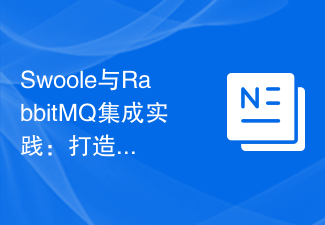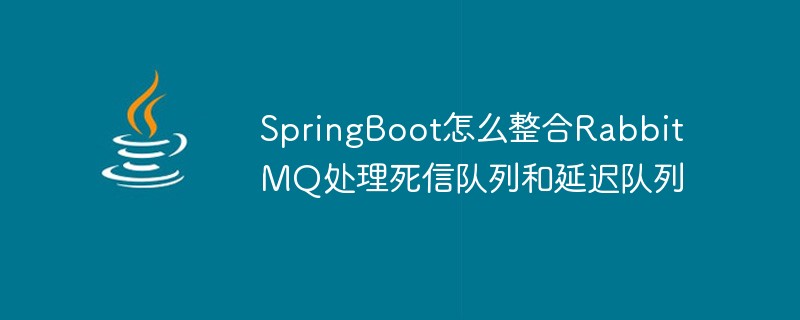The difference between rabbitmq and kafka: 1. Language and platform; 2. Message passing model; 3. Reliability; 4. Performance and throughput; 5. Cluster and load balancing; 6. Consumption model; 7. Purposes and scenarios; 8. Community and ecosystem; 9. Monitoring and management; 10. Other characteristics. Detailed introduction: 1. Language and platform. RabbitMQ is developed by Erlang language and is mainly used to transmit real-time messages between systems that require reliable message delivery. Kafka is developed by Scala language and so on.

The operating system for this tutorial: Windows 10 system, DELL G3 computer.
RabbitMQ and Kafka are two widely used message queue systems, and they have some key differences in design and use. The following is a detailed analysis of the difference between RabbitMQ and Kafka:
1. Language and platform:
- RabbitMQ: It is developed by the Erlang language and is mainly used Used for delivering real-time messages between systems that require reliable messaging. Erlang is a concurrency-oriented programming language that is particularly suitable for building distributed and fault-tolerant systems.
- Kafka: It is developed by the Scala language and is mainly used to handle active streaming data and large-volume data processing. Scala is also a concurrency-oriented language and is compatible with Java, which allows Kafka to run in a Java environment.
2. Message passing model:
- RabbitMQ: It uses AMQP (Advanced Message Queuing Protocol), which is a dedicated asynchronous messaging model Designed network protocols. RabbitMQ's broker consists of Exchange, Binding, Queue and other components.
- Kafka: It adopts a publish/subscribe model, in which message producers publish messages to specific topics, and consumers subscribe to these topics to obtain messages. The broker in Kafka consists of partitions.
3. Reliability:
- RabbitMQ: It provides a high level of reliability, including message persistence, transaction support and message confirmation mechanism. This means that even if the service crashes or is restarted, messages are not lost and clients can be sure that messages have been processed correctly when processing them.
- Kafka: It does not provide transaction support, but guarantees throughput by storing messages in partitions and allowing consumers to read data from these partitions. However, it may experience duplicate or lost messages, especially under high load.
4. Performance and throughput:
- RabbitMQ: Although it may encounter performance problems when processing large amounts of data, due to its Message persistence and reliable transmission mechanism, it is usually used in scenarios that require reliable message delivery, such as financial transactions or event notifications.
- Kafka: Due to its stream processing method and high-performance design, Kafka is able to handle larger amounts of data. It is commonly used in scenarios such as big data processing, real-time stream analysis, and log aggregation. Kafka can handle highly concurrent messages and has higher throughput.
5. Clustering and load balancing:
- RabbitMQ: It does not support load balancing itself and needs the help of an external load balancer. Balancing and failover of services. This may increase the complexity of the system.
- Kafka: Kafka’s cluster design enables automatic load balancing. Topic partitions can be automatically redistributed even when brokers are added or removed from the cluster.
6. Consumption model:
- RabbitMQ: It uses the push method, that is, the consumer actively pulls messages from the broker. This approach allows consumers to have more fine-grained control over the messages they pull.
- Kafka: It uses the pull method, that is, the consumer pulls data from the broker. This approach allows Kafka to better control the consumption speed and prevent data loss caused by consumers consuming too quickly.
7. Uses and scenarios:
- RabbitMQ: Due to its high reliability and real-time nature, it is often used in scenarios that require real-time and reliable messaging, such as financial transactions, event-driven architecture, etc.
- Kafka: Due to its high performance and large capacity characteristics, it is often used in scenarios such as big data processing, real-time stream analysis and log aggregation, especially in scenarios where large amounts of active data need to be processed.
8. Community and Ecosystem:
- RabbitMQ: Due to its long history and mature ecosystem, it is used in many enterprises and projects It has been widely used and recognized. Its community is active and mature, offering a wealth of plugins and integrations.
- Kafka: Although Kafka is relatively new, its rapid growth and widespread adoption have made it one of the standards for stream processing. Its community is large and active, with many companies and open source projects using and contributing to Kafka's ecosystem.
9. Monitoring and management:
- RabbitMQ: Provides a wealth of monitoring and management tools, such as Dashboard, HTTP API and command line tools etc., to facilitate users to view and manage the status and performance indicators of components such as queues, switches, and consumers.
- Kafka: It also provides similar monitoring and management tools, such as command line interface, JMX indicators and Confluent Control Center, etc., which can help users monitor and manage the performance and status of Kafka cluster.
10. Other features:
- RabbitMQ: Provides more advanced features, such as transaction support, message persistence and message confirmation mechanism Etc., these characteristics make it perform well in scenarios that require high reliability and real-time performance.
- Kafka: Due to its stream processing method and large-capacity characteristics, it performs well in big data processing and real-time stream analysis. At the same time, due to its partitioning nature, it is able to handle higher concurrency and has greater scalability.
The above is the detailed content of What is the difference between rabbitmq and kafka. For more information, please follow other related articles on the PHP Chinese website!
 如何在PHP中使用RabbitMQ实现分布式消息处理Jul 18, 2023 am 11:00 AM
如何在PHP中使用RabbitMQ实现分布式消息处理Jul 18, 2023 am 11:00 AM如何在PHP中使用RabbitMQ实现分布式消息处理引言:在大规模应用程序开发中,分布式系统已成为一个常见的需求。分布式消息处理是这样的一种模式,通过将任务分发到多个处理节点,可以提高系统的效率和可靠性。RabbitMQ是一个开源的,可靠的消息队列系统,它采用AMQP协议来实现消息的传递和处理。在本文中,我们将介绍如何在PHP中使用RabbitMQ来实现分布
 在Go语言中使用RabbitMQ:完整指南Jun 19, 2023 am 08:10 AM
在Go语言中使用RabbitMQ:完整指南Jun 19, 2023 am 08:10 AM随着现代应用程序的复杂性增加,消息传递已成为一种强大的工具。在这个领域,RabbitMQ已成为一个非常受欢迎的消息代理,可以用于在不同的应用程序之间传递消息。在这篇文章中,我们将探讨如何在Go语言中使用RabbitMQ。本指南将涵盖以下内容:RabbitMQ简介RabbitMQ安装RabbitMQ基础概念Go语言中的RabbitMQ入门RabbitMQ和Go
 SpringBoot怎么整合RabbitMQ实现延迟队列May 16, 2023 pm 08:31 PM
SpringBoot怎么整合RabbitMQ实现延迟队列May 16, 2023 pm 08:31 PM如何保证消息不丢失rabbitmq消息投递路径生产者->交换机->队列->消费者总的来说分为三个阶段。1.生产者保证消息投递可靠性。2.mq内部消息不丢失。3.消费者消费成功。什么是消息投递可靠性简单点说就是消息百分百发送到消息队列中。我们可以开启confirmCallback生产者投递消息后,mq会给生产者一个ack.根据ack,生产者就可以确认这条消息是否发送到mq.开启confirmCallback修改配置文件#NONE:禁用发布确认模式,是默认值,CORRELATED:
 go-zero与RabbitMQ的应用实践Jun 23, 2023 pm 12:54 PM
go-zero与RabbitMQ的应用实践Jun 23, 2023 pm 12:54 PM现在越来越多的企业开始采用微服务架构模式,而在这个架构中,消息队列成为一种重要的通信方式,其中RabbitMQ被广泛应用。而在go语言中,go-zero是近年来崛起的一种框架,它提供了很多实用的工具和方法,让开发者更加轻松地使用消息队列,下面我们将结合实际应用,来介绍go-zero和RabbitMQ的使用方法和应用实践。1.RabbitMQ概述Rabbit
 Swoole与RabbitMQ集成实践:打造高可用性消息队列系统Jun 14, 2023 pm 12:56 PM
Swoole与RabbitMQ集成实践:打造高可用性消息队列系统Jun 14, 2023 pm 12:56 PM随着互联网时代的到来,消息队列系统变得越来越重要。它可以使不同的应用之间实现异步操作、降低耦合度、提高可扩展性,进而提升整个系统的性能和用户体验。在消息队列系统中,RabbitMQ是一个强大的开源消息队列软件,它支持多种消息协议、被广泛应用于金融交易、电子商务、在线游戏等领域。在实际应用中,往往需要将RabbitMQ和其他系统进行集成。本文将介绍如何使用sw
 Golang中使用RabbitMQ实现任务分发与负载均衡的策略Sep 27, 2023 am 11:22 AM
Golang中使用RabbitMQ实现任务分发与负载均衡的策略Sep 27, 2023 am 11:22 AMGolang中使用RabbitMQ实现任务分发与负载均衡的策略概述:在分布式系统中,任务的分发与负载均衡是非常重要的。一种常见的解决方案是使用消息队列来实现任务的分发与处理。本文将介绍如何使用Golang和RabbitMQ实现任务的分发与负载均衡的策略,并提供具体的代码示例。RabbitMQ简介:RabbitMQ是一个可靠、可扩展、开放源代码的消息中间件,它
 SpringBoot怎么整合RabbitMQ处理死信队列和延迟队列May 15, 2023 pm 03:28 PM
SpringBoot怎么整合RabbitMQ处理死信队列和延迟队列May 15, 2023 pm 03:28 PM简介RabbitMQ消息简介RabbitMQ的消息默认不会超时。什么是死信队列?什么是延迟队列?死信队列:DLX,全称为Dead-Letter-Exchange,可以称之为死信交换器,也有人称之为死信邮箱。当消息在一个队列中变成死信(deadmessage)之后,它能被重新被发送到另一个交换器中,这个交换器就是DLX,绑定DLX的队列就称之为死信队列。以下几种情况会导致消息变成死信:消息被拒绝(Basic.Reject/Basic.Nack),并且设置requeue参数为false;消息过期;队
 PHP开发:使用 RabbitMQ 实现任务队列Jun 15, 2023 pm 05:33 PM
PHP开发:使用 RabbitMQ 实现任务队列Jun 15, 2023 pm 05:33 PM随着互联网的不断发展,网站的流量越来越大,访问量的增长带来的问题也越来越多。当用户量过大时,服务器负载会增大,这时就需要使用一些技术手段来解决这些问题。任务队列就是其中的一种方式,可以将一些耗时的操作异步执行,从而缓解服务器压力。本文将介绍如何使用RabbitMQ实现任务队列。一、什么是RabbitMQRabbitMQ是一个开源的消息中间件,它实现了


Hot AI Tools

Undresser.AI Undress
AI-powered app for creating realistic nude photos

AI Clothes Remover
Online AI tool for removing clothes from photos.

Undress AI Tool
Undress images for free

Clothoff.io
AI clothes remover

AI Hentai Generator
Generate AI Hentai for free.

Hot Article

Hot Tools

ZendStudio 13.5.1 Mac
Powerful PHP integrated development environment

MinGW - Minimalist GNU for Windows
This project is in the process of being migrated to osdn.net/projects/mingw, you can continue to follow us there. MinGW: A native Windows port of the GNU Compiler Collection (GCC), freely distributable import libraries and header files for building native Windows applications; includes extensions to the MSVC runtime to support C99 functionality. All MinGW software can run on 64-bit Windows platforms.

Notepad++7.3.1
Easy-to-use and free code editor

VSCode Windows 64-bit Download
A free and powerful IDE editor launched by Microsoft

SAP NetWeaver Server Adapter for Eclipse
Integrate Eclipse with SAP NetWeaver application server.





